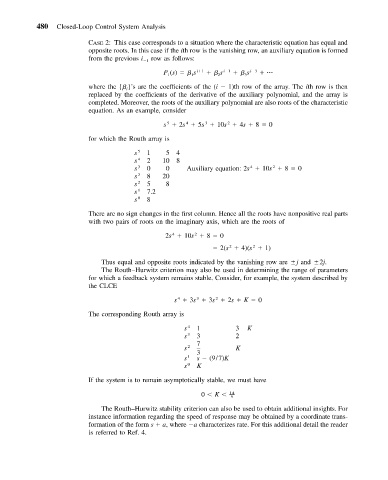Page 489 - Mechanical Engineers' Handbook (Volume 2)
P. 489
480 Closed-Loop Control System Analysis
CASE 2: This case corresponds to a situation where the characteristic equation has equal and
opposite roots. In this case if the ith row is the vanishing row, an auxiliary equation is formed
from the previous i 1 row as follows:
P (s) s i 1 s i 1 s i 3
3
2
1
1
where the { }’s are the coefficients of the (i 1)th row of the array. The ith row is then
i
replaced by the coefficients of the derivative of the auxiliary polynomial, and the array is
completed. Moreover, the roots of the auxiliary polynomial are also roots of the characteristic
equation. As an example, consider
s 2s 5s 10s 4s 8 0
5
2
3
4
for which the Routh array is
s 5 1 5 4
s 4 2 10 8
4
2
s 3 0 0 Auxiliary equation: 2s 10s 8 0
s 3 8 20
s 2 5 8
s 1 7.2
s 0 8
There are no sign changes in the first column. Hence all the roots have nonpositive real parts
with two pairs of roots on the imaginary axis, which are the roots of
4
2
2s 10s 8 0
2(s 4)(s 1)
2
2
Thus equal and opposite roots indicated by the vanishing row are j and 2j.
The Routh–Hurwitz criterion may also be used in determining the range of parameters
for which a feedback system remains stable. Consider, for example, the system described by
the CLCE
3
s 3s 3s 2s K 0
4
2
The corresponding Routh array is
s 4 1 3 K
s 3 3 2
7
s 2 K
3
s 1 s (9/7)K
s 0 K
If the system is to remain asymptotically stable, we must have
14
0 K ––
9
The Routh–Hurwitz stability criterion can also be used to obtain additional insights. For
instance information regarding the speed of response may be obtained by a coordinate trans-
formation of the form s a, where a characterizes rate. For this additional detail the reader
is referred to Ref. 4.

